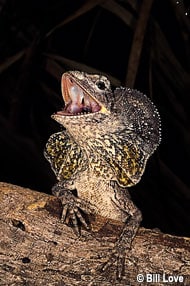Description:
One of the most recognizable herps of all, this lizard gets its name by the broad, fleshy frill of skin it expands when threatened at close range. This habit is seldom employed in captivity except when a snake is shown to induce this form of stress. Frilled lizards need a lot of room. A cage 6 feet in length is considered the minimum, and even bigger is better. Sand or gravel makes a suitable substrate, with numerous rocks and logs added to climb. At least one log should be anchored vertically so the lizard can ascend to the top for security and to bask close to a heat lamp placed above. Provide a sleeping shelter of a hollow log or ‘cave’ under a flat rock, though some frilled lizards prefer to sleep clinging to tree limbs off the ground. Chlamydosaurus is mostly carnivorous, though some fruits and vegetation are also taken. Any small animal is a potential meal for these formidable predators. Baby rodents are excellent food for adults while juvenile frilled lizards love an assortment of crickets, mealworms, waxworms, etc. Toss food items into the cage only after frilled lizards have had an hour or more to bask and warm up to optimal feeding temperatures in the morning. Most ‘frillies’ nowadays come from New Guinea populations that don’t average as large as those in Australia. Captive breeding is making them more available each year.
Habitat:
Open woodlands and grassy meadows
Range:
Northern Australia and parts of New Guinea
Scientific Name: Chlamydosaurus kingii
Species Group:
Family: Agamidae
Size: Total length up to about three feet
Level: intermediate
Weight:
Dangerous: No



